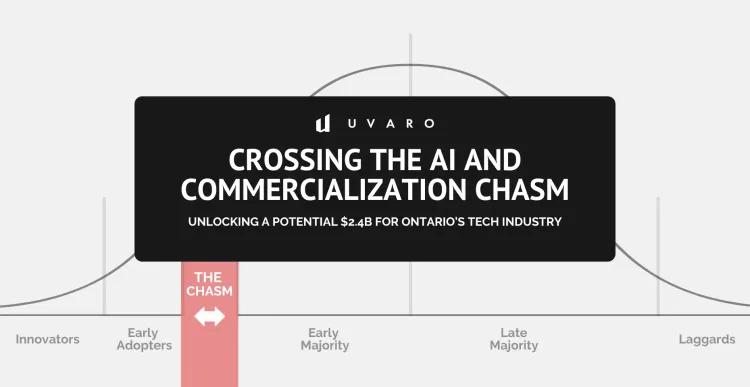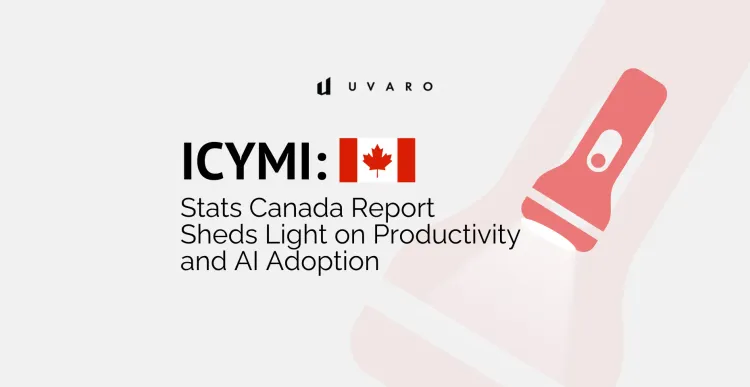Crossing the AI and Commercialization Chasm Could Unlock $2.4B for Ontario’s Tech Industry
Ontario faces two major challenges: bridging ‘The Chasm’ in AI adoption and overcoming persistent commercialization hurdles. Our scalable solution addresses both, equipping individuals with AI skills and helping businesses implement strategies to commercialize innovations. Through FedDev Ontario’s RAII program, we’re working to strengthen Ontario’s economic growth potential.

Oct 31, 2024
What can a distribution curve tell us about technology commercialization, AI adoption, and unlocking an additional $2.4B+ of potential revenue for Ontario? We’re glad you asked, because the answer is: a lot! But we’re going to start with a little math class recap to make sure we’re all on the same page, because after all, it’s a core theme of our discussion. 
A distribution curve, or a bell curve, measures probability in relation to a mean. It’s a useful tool that’s found a home in everything from financial analysis to grading student papers. It also describes how people adopt new technology, products, or services—a five-stage model we call the Technology Adoption Life Cycle, which looks a little something like this:
The first two groups—Innovators and Early Adopters—are technology enthusiasts who quickly embrace new ideas. Then we encounter pragmatists and skeptics: the Early Majority, Late Majority, and Laggards. Those first two stages account for just 16% of the general population, with the early and late majority and the laggards making up the remaining 84%.
Unlocking the majority leads to the greatest opportunities, but to fully capitalize on these, we must address two critical challenges: commercializing Canadian technology and adopting AI to support that effort. With this understanding, Uvaro has developed a scalable and modular solution to help Ontario businesses move beyond early-stage adoption so Canadian innovators can successfully commercialize their tech and our workforce remains competitive in high-value sectors with in-demand skills. With FedDev Ontario’s next round of investment, now is our chance to help Ontarians capitalize on these opportunities.
Canada’s Struggle to Cross the Chasm
So what’s getting in the way right now? After all, Canada has no shortage of startups or groundbreaking ideas, and many of these companies easily attract Innovators and Early Adopters. However, moving beyond this early audience is where many businesses begin to struggle—particularly when they venture beyond familiar borders.
While technology adoption might seem like a smooth progression, there’s a critical gap between Early Adopters and the Early Majority—right when a technology is poised to go mainstream. Geoffrey Moore, in his bestseller Crossing the Chasm, calls this gap ‘The Chasm.’ It’s a pivotal moment when companies must shift from appealing to tech enthusiasts to convincing a more cautious, mainstream audience. Updated in 2014, the book highlights specific challenges tech businesses face in making this leap.
Most tech companies fail in the Distribution Chasm. What goes wrong? This is when they need to shift from appealing to enthusiasts and visionaries seeking breakthroughs to a broader audience looking for proven, low-risk solutions. Companies that fail to cross the chasm burn cash and are left with two options: sell or shut down. To the detriment of Canadian productivity, commercialization, and innovation, most choose to sell.
The chasm is especially damaging in Canada’s high-value traded industries—like technology and software development—where goods and services are exported globally. When Canadian companies sell their intellectual property (IP), they lose the chance to scale, and the economic benefits of that IP often fuel foreign economies.
Improving the productivity of these high-value traded sectors is essential for making Canada more competitive on the global stage because they’re where our greatest growth potential lies. Technology and software in particular are key to reaching that $2.4 billion in growth we mentioned at the start (we’re getting there, we promise). When businesses in these sectors scale, commercialize their IP, and compete internationally, the economic benefits stay within Canada. This is crucial for building a stronger, more competitive economy that doesn’t just innovate but also capitalizes on that innovation.
The Talent Gap Holding Canada Back
So what’s pushing Canadian companies into the chasm and fueling the sell-off of valuable IP, if the innovations and ideas are there?
While Canada excels at producing innovative IP and attracting early-stage buyers, we struggle to scale these innovations beyond our borders. We’ve proven we can engage Innovators and Early Adopters, but the challenge is crossing the chasm to the Early Majority—largely due to a shortage of the right talent to support this transition. In plain terms, it’s not the tech. It’s the people.
Alongside those building the technology, we need people to commercialize it, market it, and close sales. Not only that, but they must be as effective as possible, fully trained, and ready to capitalize on the next wave of innovation, which right now is with AI.
This talent gap is especially critical for go-to-market strategies that allow businesses to expand beyond Canada. Without the right skills to grow and sustain their expanded presence, many companies are forced to sell prematurely, missing the chance to scale internationally. To truly drive Canadian prosperity, we need to bridge this talent gap and develop strategies to take our innovations to the global stage.
The Impact On Canada’s Bottom Line
What’s at stake if Canada doesn’t bridge the talent gap—and the distribution chasm? What happens if we let our best ideas go elsewhere?
In the short term, we lose immediate economic benefits in the billions of dollars. Let’s use Ontario’s technology sector as an example. Ontario is home to over 25,000 technology companies, contributing $48.3B to the country’s GDP every year and employing more than 420,000 workers.
Now imagine what’s possible in just a year if Canadian businesses increase their productivity.
Data suggests that sales output improves by 3%-5% when companies and individuals effectively adopt AI into their business practices. That boost translates into an additional $1.4B to $2.4B a year in growth. And that’s just within one sector!
As for the long-term impact, let’s look at two examples of companies working in our own backyard in Kitchener-Waterloo: Google and ApplyBoard. Google’s Kitchener office is the tech giant’s biggest research and development hub in Canada, where teams of engineers, designers, researchers, and managers have made major contributions to a few products you might have heard of, including Gmail, Chrome, and Ads. They have a seated capacity of 3,000, making them one of the region’s largest employers.
Don’t get us wrong. A lot of great work happens at their office here. But who benefits in the long term from it? As a U.S.-based company, the IP generated in Kitchener-Waterloo ultimately benefits the U.S. economy.
Now, walk down King Street, take a left on Frederick, and you’ll find ApplyBoard. This multi-billion-dollar Canadian company is by all measures a Canadian success story, claiming the title of “the world’s largest online platform for international student recruitment.” They sell internationally with Canadian-owned IP. The innovation that happens at their Kitchener headquarters—and by their teams in more than 30 countries around the world—benefits us right here at home.
Both companies help the local economy through job creation, but only one ensures that the long-term value—the IP—fuels Canada’s growth. It’s not about labeling one as better than the other, but about highlighting the importance of keeping that long-term value at home.
Is AI Here To Save The Day?
We’re not done with the distribution curve quite yet. because while it illustrates our commercialization challenges in Canada, we can also use it to explain a potential solution: AI adoption in Canada.
AI burst onto the scene in 2021 and is making headlines as a powerful driver of increased productivity and commercialization potential. It includes generative AI models like ChatGPT that we read about in headlines, as well as more highly technical and purpose-built models.
The potential benefits are massive: Generative AI alone is expected to add between $2.6T to $4.4T annually to the global economy through productivity improvements alone, particularly in areas like customer operations, sales and marketing, software development, and R&D. Of Canadian SMBs that use AI, a stunning 97% say the technology has benefited them through improvements in sales, costs, production management, and more.
AI adoption in Canada is growing and the numbers prove this. In 2021, only 3.7% of Canadian firms were using AI tools. Today, over 30% of SMBs in Canada have someone subscribed to ChatGPT, more than doubling from 14% just one year earlier. These numbers tell us we’ve moved from Innovators and Early Adopters and are now breaking into the Early Majority—but this is where things get tricky.
As we mentioned before, the mainstream market views technology differently than the early market. The Early Majority is more skeptical and cautious than Innovators and Early Adopters. They won’t necessarily seek out new tools or learn them on their own—they need guidance and support. We need to engage the Early Majority in the next 12 months to keep AI adoption growing. If we fail to do so, AI adoption could get lost in the chasm, and Canada risks missing out on the productivity gains that come with it.
We hear you thinking, “But isn’t the technology itself enough?” That’s a common fallacy because even the most innovative technology with the biggest potential in the world (looking at you, AI companies), can’t scale itself.
Consider that Canada is home to 10% of the world’s top AI researchers and some 1,500 companies developing AI Solutions. Built on cutting-edge research and revolutionary technology, these companies should theoretically scale into medium-sized businesses with ease, right? Yet despite the government’s 2022 strategy to translate AI research into commercial applications, three-quarters of AI patents from Canada’s top institutes—like Toronto’s Vector Institute and Montreal’s Mila—end up in the hands of Big Tech. Only 7% remain with Canadian companies.
It’s not just about the technology. It never has been. It takes much more than good research to bring something to scale. It’s about the people—the skills they bring to the table, how they work with the technology, and how they build the business around it.
Ultimately, it’s about equipping those people with the right skills and tools to bring Canadian innovation into the hands of a global market so it can cross the chasm from early adoption to mainstream success.
Our Approach: A Recipe For Productivity, Not Just Ingredients
Here’s the moment you’ve been waiting for, our solution to this challenge! We’re building a localized program that develops AI skills for individuals in the workplace while supporting businesses in building and implementing AI strategies that help them commercialize their innovations. By prioritizing go-to-market roles, we help companies break into the Early Majority market with the right strategic tools to bridge their commercialization gap and cross the Chasm in AI adoption.
We’re preparing to launch this solution in Kitchener-Waterloo and Toronto through FedDev Ontario’s Regional Artificial Intelligence Initiative in Southern Ontario. But we don’t plan to stop there. We’ve designed this solution to be scalable across Ontario. Today, we’re hard at work securing partnerships with community non-profits to lead the proposal, and building ready-to-deliver programming with a consortium of partners. Here’s how it works:
1: A 2-Sided Approach: Businesses + Workers Participate
More productive workers benefit businesses as a whole, so it’s important to bring both to the table. In this program, businesses will learn how to effectively use AI in their customer-facing departments with targeted training on specific tools and processes. This knowledge will help startups and SMBs in these critical sectors to start their journey with this new technology.
In each local region where this program runs, we will engage 50 businesses and over 250+ learners. While 50 businesses is a strong start, it represents just a small fraction of the 444,702 small businesses in Ontario. Scalability is our secret sauce–we built this model to be replicated across the province so we can make a broader impact as we partner with more regions and sectors. Businesses have a key role to play, and how we engage with them is what makes this solution unique.
2: AI At The Core—And A Full Catalog Of Support
Our program places AI skills at the core to boost productivity for both businesses and workers. By combining live classroom instruction with work-integrated learning (we call it WIL), participants gain practical tools and experience to drive efficiency in their day-to-day roles. Businesses, in turn, learn to apply these skills, improving operations and creating lasting impact at scale.
In addition, our open-access catalog empowers members to explore beyond their immediate learning goals. With go-to-market courses and resources that advance their skill sets, our catalog fuels growth across critical digital, technical, and soft skills, giving them the confidence to adapt in an ever-evolving workforce.
3: Work Integrated Learning Connects It All
WIL is one of the most effective ways we bring businesses and learners together. Participants engage in WIL projects that provide practical experience, allowing them to apply what they learn to real business challenges in real-world environments. At the same time, businesses benefit from short-cycle WIL projects to stand up their AI strategies, gaining practical solutions while learners develop essential hands-on skills.
We’ve partnered with Riipen, Canada’s leading work-based learning platform, to ensure these projects deliver measurable outcomes for both learners and companies, reinforcing the impact of our program.
What Comes Next
The call for proposals from FedDev Southern Ontario is now open, and our solution is ready. With key partners already on board in Kitchener-Waterloo and Toronto, we’re looking for additional regional and local partners to expand this solution to more businesses and workers across Ontario.
We invite you to join us in bringing this program to your region. By partnering with us, you’ll help ensure that more Ontario businesses have the tools they need to adopt AI and commercialize their innovations, reaching the 84% of workers who have yet to embrace these new tools. Together, we can drive a new wave of growth and innovation across the province!
INTERESTED IN PARTNERING TO BRING THIS SOLUTION TO YOUR COMMUNITY?
Connect with our Partnerships Team to learn more





